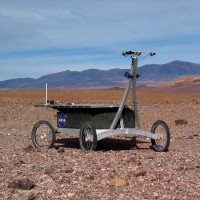For the most current information, see our official project page.
Evidence suggests that the interior of the Chilean Atacama Desert, the most arid region on Earth, is also the most lifeless. Yet where the desert meets the Pacific Coastal Range desiccation-tolerant microorganisms are known to exist. In some areas of the desert interior bacteria survive in porous rock and the under the surface crust of salty soils. The gradient of biodiversity and variety of habitats of life in the Atacama’s subregions remain largely unexplored.
Robotic field investigation will bring new scientific understanding of the Atacama as a habitat for life with distinct analogies to Mars. Our goal is to make genuine discoveries about the limits of life on Earth and to generate knowledge about life in extreme environments that can be applied to future planetary missions. To conduct this investigation we have developed Robotic Astrobiology.
Field investigation over three years will use a rover to make transects of the Atacama with instruments to detect microorganisms and to characterize habitats. The rover will integrate panoramic imagers, microscopic imagers, spectrometers, as well as a drill for shallow subsurface access. Robotic considerations in addition to instrument integration include planetary-relevant localization, over-the-horizon navigation, power-cognizant planning, and science data understanding
The measurement and exploration techniques produced by this investigation combines long traverses, sampling measurements on a regional scale and detailed measurements of individual targets. When compared to the state of the art in robotic planetary exploration our approach will result in dramatic increase in the number of measurements made and data collected by rover instruments per command cycle. This result will translate into substantial productivity increases for future planetary exploration missions.
current head
current staff
current contact
past staff
- Guoming Alex Long



